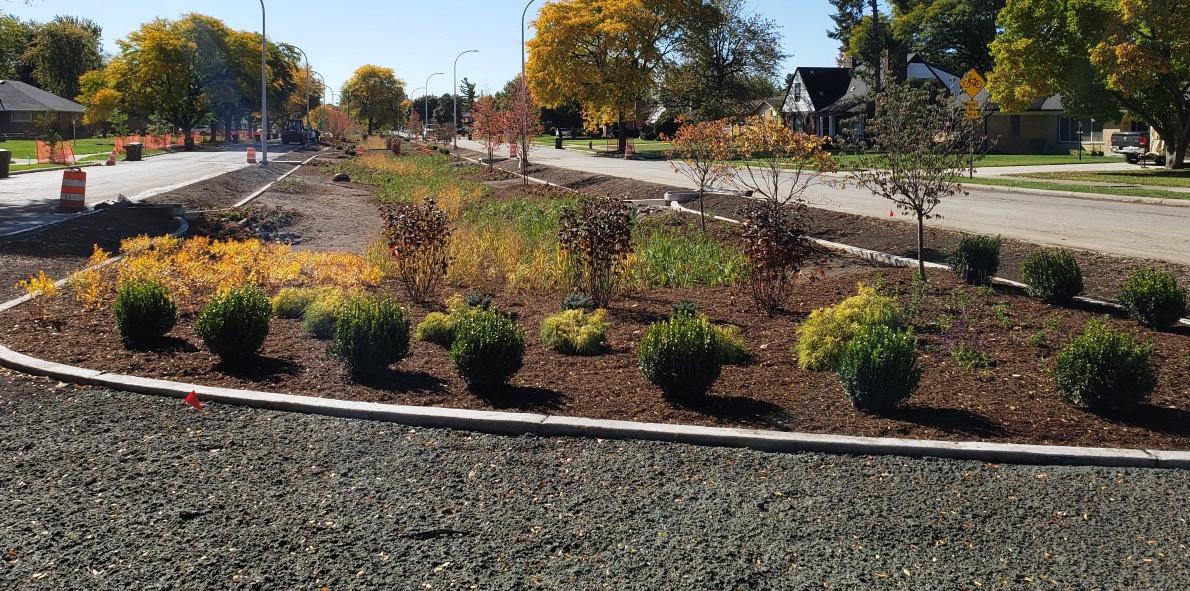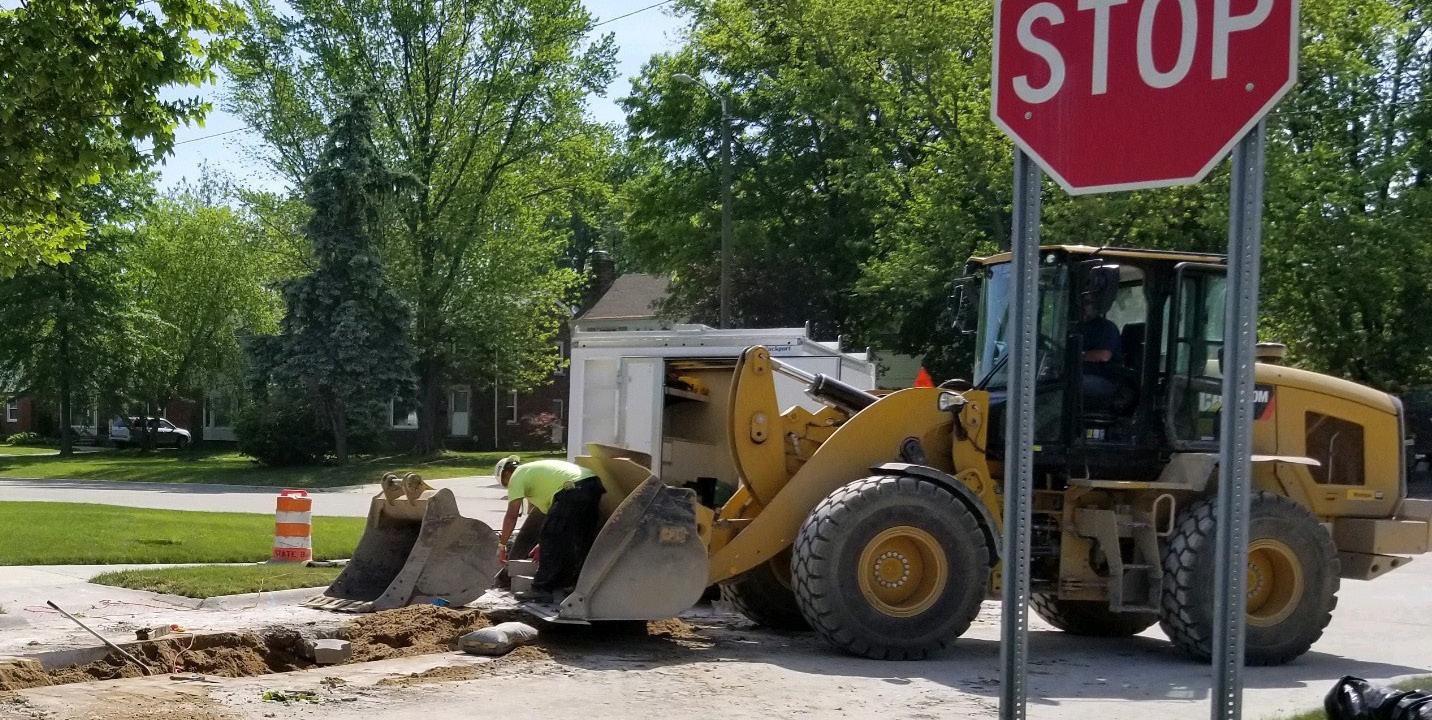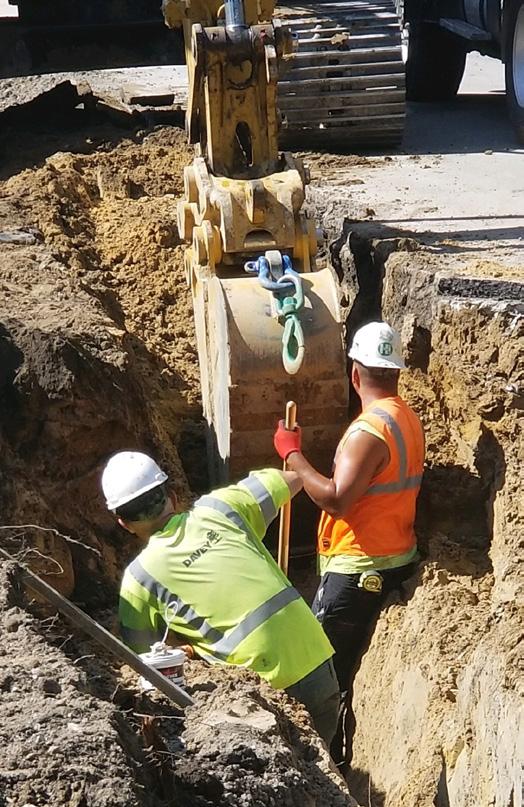
6 minute read
Stormwater Management
Improving Stormwater Management
DWSD is now managing 61 million gallons of stormwater annually through 16 GSI projects.
Advertisement
Community Input Led to Beautiful Medians that Manage Stormwater on Oakman Boulevard
Back in 2017, DWSD began hosting meetings with the Aviation Sub, sharing design options for the Green Stormwater Infrastructure (GSI) in the medians along Oakman Boulevard between Joy Road and Tireman Avenue. Residents in the community provided feedback on trees, plantings, and other features during these meetings. They also considered passive versus active, park like settings. The final design included their input of a passive setting. A final pre-construction meeting was held in 2020 before the COVID-19 Pandemic at Rippling Hope to share the project plans and timeline with the community, and it included the primary construction contractor, Detroit-based and minority-owned Blaze Contracting.
During the official project announcement in 2020, Mayor Mike Duggan praised the DWSD Oakman Boulevard project as an example of, “Detroiters rebuilding Detroit,” with the announcement of Detroitbased Blaze Contracting as the primary contractor for the project.
Oakman Boulevard GSI Overview
The $8.6 million Oakman Boulevard construction project is the city’s largest investment to date in GSI.
The most common method to improve stormwater management is through GSI practices. It replicates natural systems to reduce runoff volume, filter pollutants, and cut down on flooding by slowing the movement of water into the combined sewer system and channeling it into the ground.
During construction, DWSD’s contractor converted 10 medians into bioretention gardens, including the median shown above on Oakman Boulevard south of Mackenzie. Those gardens will manage an estimated 37 million gallons of stormwater annually, and reduce the flow into our combined sewer system.
“Even after the delayed start due to COVID-19 stayat-home orders, Blaze and its subcontractors were able to complete major construction by the end of 2020. And, they did so with 48 Detroit residents working on the project. This historic Detroit neighborhood will see the beauty these gardens bring while benefiting mostly from reduced street flooding,” said Palencia Mobley, P.E., DWSD Deputy Director & Chief Engineer.
Visit www.detroitstormwater.org to see both the public and private GSI projects in Detroit.
DWSD’s Goals
DWSD’s goal is to improve service delivery and quality of life by:
• Reducing water main breaks;
• Reducing street flooding and sewer system failures;
• Reducing future investment in new CSO facilities (wet weather treatment);
• Increasing acres managed by green stormwater infrastructure;
• Coordinating with other public and private agencies to maximize dollars invested and minimize disruption from construction activity;
• Increasing job opportunities for Detroiters; and
• Upgrading and maintaining facilities, equipment and systems for effective operations.
Upgrading Detroit’s Water and Sewer Systems

DWSD is in its second year of its $500 million Capital Improvement Program (CIP) to begin to upgrade the city’s aging water infrastructure by replacing water mains, lead service lines and fire hydrants, relining sewer pipes, and installing green stormwater infrastructure. In 2018, DWSD began assessing water and sewer systems by neighborhood using condition assessments, rather than by the number of water main breaks and basement backups to avoid taking a scattered approach.
Since 2019 through the CIP, DWSD has replaced 66 miles of water main, upgraded 50 miles of sewer piping, replace more than 1,155 lead service lines and installed 11 bioretention gardens.
Despite the pause in construction due to Governor Gretchen Whitmer’s COVID-19 Stay Home, Stay Safe Order, DWSD CIP projects have stayed on schedule. The Oakman Boulevard Stormwater and Water System Upgrade Project was mostly completed in November 2020. This $8.6 million project transformed 10 medians into bioretention to manage 37 million gallons of stormwater annually (see Stormwater article on page 12).
The $44.3 million invested into Cornerstone Village and North Rosedale Park, the first two neighborhoods under the new approach, is on track to finish in December 2022.
Since 2019, DWSD has assessed the water and sewer systems in more than 20 neighborhoods, resulting in water and sewer upgrades in neighborhoods such as the North End. In 2021, DWSD will complete an additional 225 miles of water main condition assessment work across 39 neighborhoods to test hydrant flow, leak detection and more to identify neighborhoods in need of water main upgrades.

These photographs were taken prior to the COVID-19 outbreak
Substances Found in Source Water
The sources of drinking water (both tap water and bottled water) include rivers, lakes, streams, ponds, reservoirs, springs and wells.
As water travels over the surface of the land or through the ground, it dissolves naturally occurring minerals and, in some cases, radioactive materials and can pick up substances resulting from the presence of animal or human activity.
Contaminants that may be present in source water include:
• Microbial contaminants, such as viruses and bacteria, which may come from sewage treatment plants, septic systems, agricultural livestock operations and wildlife;
• Inorganic contaminants, such as salts and metals, which can be naturally occurring or result from urban stormwater runoff, industrial or domestic wastewater discharges, oil and gas production, mining or farming;
• Pesticides and herbicides, which may come from a variety of sources such as agriculture, urban stormwater runoff and residential uses;
• Organic chemical contaminants, including synthetic and volatile organics, which are byproducts of industrial processes and petroleum production, which also can come from gas stations, urban stormwater runoff and septic systems; and
• Radioactive contaminants, which can be naturally occurring or the result of oil and gas production and mining activities.
In order to ensure tap water is safe to drink, the EPA prescribes regulations that limit the amount of certain contaminants in water provided by public water systems. U.S. Food and Drug Administration regulations establish limits for contaminants in bottled water, which must provide the same protection for human health.
Drinking water, including bottled water, may reasonably be expected to contain small amounts of some contaminants. The presence of contaminants does not necessarily indicate that water poses a health risk. More information about contaminants and potential health effects can be obtained by calling the EPA’s Safe Drinking Water Hotline at 800-426-4791.
Source Water Protection
Your source water comes from the Detroit River, situated within the Lake St. Clair, Clinton River, Detroit River, Rouge River, Ecorse River, watersheds in the U.S. and parts of the Thames River, Little River, Turkey Creek and Sydenham watersheds in Canada. The Michigan Department of Environmental Quality in partnership with the U.S. Geological Survey, the Detroit Water and Sewerage Department, and the Michigan Public Health Institute performed a source water assessment in 2004 to determine the susceptibility of GLWA’s Detroit River source water for potential contamination. The susceptibility rating is based on a seven-tiered scale and ranges from very low to very high determined primarily using geologic sensitivity, water chemistry, and potential contaminant sources. The report described GLWA’s Detroit river intakes as highly susceptible to potential contamination. However, all four GLWA water treatment plants that service the city of Detroit and draw water from the Detroit River have historically provided satisfactory treatment and meet drinking water standards.
GLWA has initiated source-water protection activities that include chemical containment, spill response, and a mercury reduction program. GLWA participates in the National Pollutant Discharge Elimination System permit discharge program and has an emergency response management plan. In 2016, the Michigan Department of Environmental, Great Lakes and Energy approved the GLWA’s Surface Water Intake Protection plan for the Belle Isle intake and Fighting island intakes. The plan has seven elements that include: roles and duties of government units and water supply agencies, delineation of a source water protection areas, identification of potential sources of contamination, management approaches for protection, contingency plans, siting of new water sources, public participation, and public education activities. GLWA is in the process of updating the plans which should be completed by September 2021. If you would like to know more information about the Source Water Assessment report please, contact GLWA at 313-926-8102.








